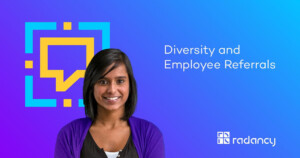What Is an Employee Referral Program?
Many companies are faced with increasingly challenging talent shortages making it difficult to fill vacancies with suitable candidates and specialists. In the search for a successful recruiting channel, companies refer to employee referrals. Personal referrals from your employee’s networks offer the company a large pool of talent and passive candidates they would otherwise not be able to reach.
Employee referral programs are straightforward and have been used one way or another for a long time. Nowadays, we use digital tools to manage referrals. Your employees share open positions with their network through social media or direct referrals and refer suitable talent to you. Not only do employee referrals help to fill vacancies but they simultaneously also convey your employer brand in a positive way to the outside world and increase your employees’ loyalty towards the company, thus reducing employee turnover.
Yet, what does all this have to do with Diversity, Equity & Inclusion?
Diversity in Companies: Why It Is So Important?
Today’s labor market demands creative thinking and openness to new ideas. To introduce sustainable innovations, companies need to establish an open-minded atmosphere and gather many different sources of ideas. Such a lively and creative working atmosphere encourages people to fully exploit their potential and work towards the company’s goals with a high level of motivation.
No successful company can do without such engaged employees with a variety of different backgrounds. Focusing on diversity and equal opportunities is therefore much more than just paying lip service to being trendy. It means bringing together people with different social or ethnic backgrounds, different sexual orientations, cultural backgrounds, and individual skills to form teams that thrive on tolerance and openness to differences. This not only creates the external image of a company in which discrimination has no chance but actually transforms the company into a diverse space!
Above all, it creates a diverse culture of knowledge, one that values each individual as a valuable member of the team. As a result, employees complement each other, learn from each other, and develop ideas together that a homogeneous team would never have come up with. This is especially true when different generations work together in a company. Generational diversity in different teams can therefore increase the success of a company in the long term[1].
Hiring for Cultural Fit: Keeping Corporate Culture in Mind
An applicant and a company come together when their values and behaviors are a good match. There is a Cultural Fit. It simply fits. Yet, if a homogeneous workforce uses its private networks, only more referred candidates with the same cultural background will apply. As a result, diversity, equity and inclusion experts take a critical view of Cultural Fit. They argue that the concept of Cultural Fit can lead to more uniformity or even exclusion[2]. that is why it is better to review the guiding principles and goals of the corporate culture and then implement a referral program in a targeted manner. In this way, you promote diversity within the company.
Culture Fit and Culture Add – What Is the Difference?
In addition to the term Culture Fit, which is quickly associated with prejudices, restrictions, and possibly the overlooking of valuable skills, the term Culture Add, which is seen as a cultural addition, has been gaining ground for some time now.[2] These employees bring less “overlap” with the existing team, but enrich it with all kinds of new perspectives, expertise and skills.
Especially when it comes to conquering and growing new markets, areas or sectors with the company, new perspectives are indispensable and promising. It is therefore not worth hiring new employees who fit the corporate culture, but rather those who complement the existing culture. They bring new energy and impetus to your company.[3]
It is important for companies to find a good balance and the right mix between Cultural Fit and Cultural Add.
Do Employee Referral Programs Put Diversity at Risk? No!
A diverse and cosmopolitan corporate culture is not established in a day. This makes it all the more important to start with efficient diversity management at an early stage. To this end, it is important to recognize and make use of the diversity that already exists within the company.
If integration has already been successful, many employees are often not even aware that they have colleagues with same-sex partners, a migration background or different religious beliefs. This is because these differences have long since become so normal in everyday working life that they feel like common ground. After all, everyone enjoys working together constructively. Recruiting via referrals can build on precisely this integration that has already become commonplace.
Diversity exists in every company, but it may have yet to be addressed. An employee referral program breaks down boundaries and barriers. It enables every employee with their background to refer their own company as an employer. From female managers to bilingual wheelchair users, every team member can use their private network as a recruiting channel. This strengthens diversity. And it does so in a simple, trust-based way. After all, who better to strengthen an open-minded employer brand than your own employees?
A well-designed digital employee referral program offers a wide range of possible applications. This allows companies to specifically promote diversity in
their teams and benefit from a wealth of different experience and knowledge. This promotes the generation of new ideas and creativity and leads to
innovative solutions. Employee referrals have a positive effect on employee satisfaction and have a direct impact on company performance and success.

Want to know how you can use employee referrals to increase diversity in your company? Find out more in our white paper “Diversity and Employee Referrals“.
Sources
[1] Radancy. Whitepaper. Diversity and Employee Referrals. https://www.radancy.com/de/whitepaper-und-guides/diversity-in-unternehmen-whitepaper/
[2] Grill. C. 18.01.2023. Culture Fit vs. Culture Add. Great Place To Work. Retrieved on 9th March, 2024 via https://www.greatplacetowork.at/blog/darum-ersetzt-im-recruiting-der-cultural-add-den-culture-fit/
[3] Montgomery. L. 08.06.2022. Culture Fit Versus Culture Add: Hiring For Growth. forbes. Retrieved on 9th March, 2024 via https://www.forbes.com/sites/forbeshumanresourcescouncil/2022/06/08/culture-fit-versus-culture-add-hiring-for-growth/




















